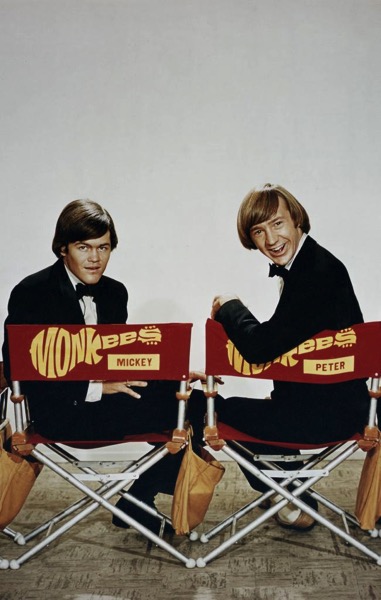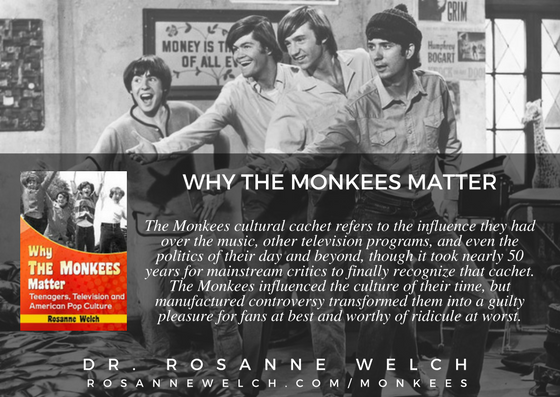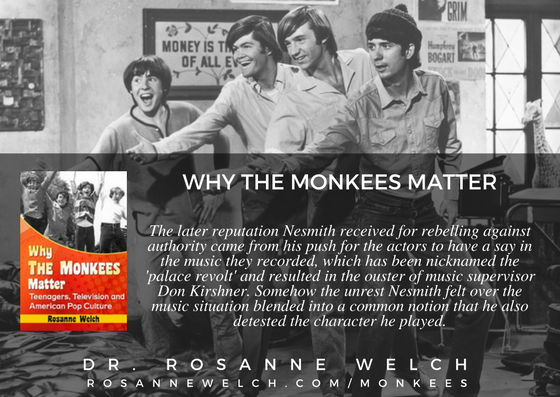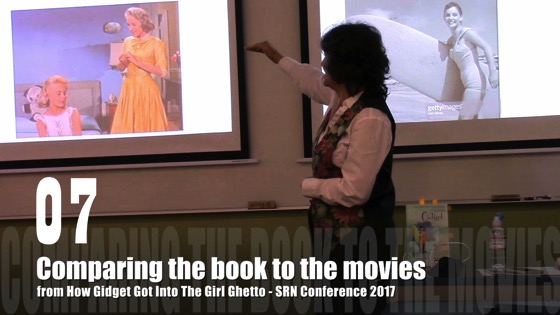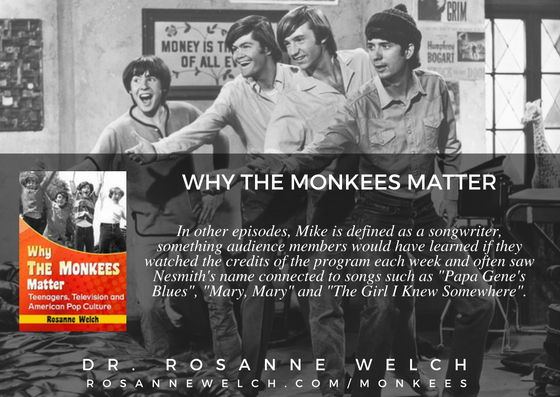Why The Monkees Matter: Teenagers, Television and American Pop Culture
Category: Television
Quotes from “Why The Monkees Matter” by Dr. Rosanne Welch – 90 in a series – Cultural Cachet
** Buy “Why The Monkees Matter” Today **
The Monkees cultural cachet refers to the influence they had over the music, other television programs, and even the politics of their day and beyond, though it took nearly 50 years for mainstream critics to finally recognize that cachet. The Monkees influenced the culture of their time, but manufactured controversy transformed them into a guilty pleasure for fans at best and worthy of ridicule at worst.
from Why The Monkees Matter by Dr. Rosanne Welch — Buy your Copy today!
Why The Monkees Matter: Teenagers, Television and American Pop Culture
McFarland (Direct from Publisher) | Amazon | Kindle Edition | Nook Edition
08 More on comparing The Book To The Movies from How Gidget Got Into the Girl Ghetto – Dr. Rosanne Welch – SRN Conference
Watch this entire presentation
Transcript:
In the book, she makes all the decisions about her own life as I said, including whether or not to have sex with a really cute surfer. In the movie, her boyfriend makes all the decisions about whether or not they’ll be together and I didn’t even think about that until I watched all the sequels and I kept waiting and it was always him breaking up with her and her waiting for him to come back to her. I thought Oh this is just a disaster and sad and scary in many ways. This really struck me, too. In the book, this is her conclusion. Her definition of who she is. “The summer with Jeff could have been just a dream, but with the board and the sun and the waves it was for real. Maybe I was just a woman in love with a surfboard. It’s a simple as that.” That’s literally the thesis of her own book. In the movie, it was getting pinned by her boyfriend which was the absolute ultimate moment in her life. I mean you can’t water it down any more than that. It fascinates me and yet this is mythology that is known about Gidget and it’s not her true story at all — which really makes me sad.
At this year’s 10th Annual Screenwriting Research Network Conference at Otago University in Dunedin, New Zealand I presented…
“How Gidget Got Into the Girl Ghetto by Accident (and How We Can Get Her Out of it): Demoting Gidget: The Little Girl with Big Ideas from Edgy Coming of Age Novel to Babe on the Beach Genre Film via Choices made in the Adaptation Process.”
It’ a long title, as I joke up front, but covers the process of adapting the true life story of Kathy Kohner (nicknamed ‘Gidget’ by the group of male surfers who she spent the summers with in Malibu in the 1950s) into the film and television series that are better remembered than the novel. The novel had been well-received upon publication, even compared to A Catcher in the Rye, but has mistakenly been relegated to the ‘girl ghetto’ of films. Some of the adaptations turned the focus away from the coming of age story of a young woman who gained respect for her talent at a male craft – surfing – and instead turned the focus far too much on Kathy being boy crazy.
Along the way I found interesting comparisons between how female writers treated the main character while adapting the novel and how male writers treated the character.
Dr. Rosanne Welch
Dr. Rosanne Welch teaches the History of Screenwriting and One-Hour Drama for the Stephens College MFA in Screenwriting.
Writing/producing credits include Beverly Hills 90210, Picket Fences, ABCNEWS: Nightline and Touched by an Angel. In 2016 she published the book Why The Monkees Matter: Teenagers, Television and American Pop; co-edited Women in American History: A Social, Political, and Cultural Encyclopedia; and placed “Transmitting Culture Transnationally Via the Characterization of Parents in Police Procedurals” in the New Review of Film and Television Studies. Essays appear in Torchwood Declassified: Investigating Mainstream Cult Television and Doctor Who and Race: An Anthology. Welch serves as Book Reviews editor for Journal of Screenwriting and on the Editorial Advisory Board for Written By magazine, the magazine of the Writers Guild.
Watch Dr. Welch’s talk “The Importance of Having a Female Voice in the Room” at the 2016 TEDxCPP.
The Screenwriting Research Network is a research group consisting of scholars, reflective practitioners and practice-based researchers interested in research on screenwriting. The aim is to rethink the screenplay in relation to its histories, theories, values and creative practices.
Podcast: Play in new window | Download
Subscribe: RSS
From The Research Vault: Teenagers: An American History. Palladino, Grace. T, New York: Basic Books, 1996.
Quotes from “Why The Monkees Matter” by Dr. Rosanne Welch – 89 in a series – Mike The Rebel
** Buy “Why The Monkees Matter” Today **
The later reputation Nesmith received for rebelling against authority came from his push for the actors to have a say in the music they recorded, which has been nicknamed the ‘palace revolt’ and resulted in the ouster of music supervisor Don Kirshner. Somehow the unrest Nesmith felt over the music situation blended into a common notion that he also detested the character he played. .
from Why The Monkees Matter by Dr. Rosanne Welch — Buy your Copy today!
Why The Monkees Matter: Teenagers, Television and American Pop Culture
McFarland (Direct from Publisher) | Amazon | Kindle Edition | Nook Edition
07 Comparing The Book To The Movies from How Gidget Got Into the Girl Ghetto – Dr. Rosanne Welch – SRN Conference
Watch this entire presentation
Transcript:
It really hurt me to watch these generations of women discuss the business of being a woman and their dismissing her skill entirely.
Audience: Which year is the film? In which year was that a film, sorry?
The film is 1959. Thank you, sorry. Yes, 1959. We’re going to move into the 1960s with the next 2 sequels and the show.
So this is typical when a guy writes it and also the difference between the book and the films. In the book, she has a friend who’s an aspiring playwright. Gidget herself is reading Rachel Carson because Rachel Carson’s book Silent Spring was about how we were affecting the environment and the environment means everything to her because that’s where the surf is. In the movie, she doesn’t read because that’s a boring thing for a girl to do. Her father’s a professor, in the movie he’s kind of a sitcom goof-off. He’s actually played by Carl Reiner in one of the sequels. She wants to learn to surf. that’s her “character want.” If we scripting this story. In this she want’s a boyfriend. I mean entirely take away the thing that makes her special and different.
At this year’s 10th Annual Screenwriting Research Network Conference at Otago University in Dunedin, New Zealand I presented…
“How Gidget Got Into the Girl Ghetto by Accident (and How We Can Get Her Out of it): Demoting Gidget: The Little Girl with Big Ideas from Edgy Coming of Age Novel to Babe on the Beach Genre Film via Choices made in the Adaptation Process.”
It’ a long title, as I joke up front, but covers the process of adapting the true life story of Kathy Kohner (nicknamed ‘Gidget’ by the group of male surfers who she spent the summers with in Malibu in the 1950s) into the film and television series that are better remembered than the novel. The novel had been well-received upon publication, even compared to A Catcher in the Rye, but has mistakenly been relegated to the ‘girl ghetto’ of films. Some of the adaptations turned the focus away from the coming of age story of a young woman who gained respect for her talent at a male craft – surfing – and instead turned the focus far too much on Kathy being boy crazy.
Along the way I found interesting comparisons between how female writers treated the main character while adapting the novel and how male writers treated the character.
Dr. Rosanne Welch
Dr. Rosanne Welch teaches the History of Screenwriting and One-Hour Drama for the Stephens College MFA in Screenwriting.
Writing/producing credits include Beverly Hills 90210, Picket Fences, ABCNEWS: Nightline and Touched by an Angel. In 2016 she published the book Why The Monkees Matter: Teenagers, Television and American Pop; co-edited Women in American History: A Social, Political, and Cultural Encyclopedia; and placed “Transmitting Culture Transnationally Via the Characterization of Parents in Police Procedurals” in the New Review of Film and Television Studies. Essays appear in Torchwood Declassified: Investigating Mainstream Cult Television and Doctor Who and Race: An Anthology. Welch serves as Book Reviews editor for Journal of Screenwriting and on the Editorial Advisory Board for Written By magazine, the magazine of the Writers Guild.
Watch Dr. Welch’s talk “The Importance of Having a Female Voice in the Room” at the 2016 TEDxCPP.
The Screenwriting Research Network is a research group consisting of scholars, reflective practitioners and practice-based researchers interested in research on screenwriting. The aim is to rethink the screenplay in relation to its histories, theories, values and creative practices.
Podcast: Play in new window | Download
Subscribe: RSS
From The Research Vault: Phyllis (Nesmith) Gibson. Obituary. (2010, February 25). Los Angeles Times.
06 From Book To Movie from How Gidget Got Into the Girl Ghetto – Dr. Rosanne Welch – SRN Conference
06 From Book To Movie from How Gidget Got Into the Girl Ghetto – Dr. Rosanne Welch – SRN Conference
Watch this entire presentation
Transcript:
…and yet we don’t read books about a girl’s coming of age and Gidget turns out to be just such a thing. About a woman who goes to the beach to learn a skill. Yes, she meets some boys along the way and, of course, she finds one or two of them handsome, but she also makes choices about whether or not to have sex and that is a huge moment in the coming of age of a girl. Nobody takes advantage of her which tends to be the way the story goes. She makes the choices and the men respect her for it and thought that was fascinating when I read this book. So, Hollywood gets a hand of this book and they have to do something with it. They have to make it silly. So, in the real world, this is what she has to say. This book is all about how much she loves surfing and that’s a picture of the real Kathy Kohner back in the day with her surfboard. That is how she identified herself. We get to the movies and this is some typical dialogue. Yeah, the cringing can start at any time.
At this year’s 10th Annual Screenwriting Research Network Conference at Otago University in Dunedin, New Zealand I presented…
“How Gidget Got Into the Girl Ghetto by Accident (and How We Can Get Her Out of it): Demoting Gidget: The Little Girl with Big Ideas from Edgy Coming of Age Novel to Babe on the Beach Genre Film via Choices made in the Adaptation Process.”
It’ a long title, as I joke up front, but covers the process of adapting the true life story of Kathy Kohner (nicknamed ‘Gidget’ by the group of male surfers who she spent the summers with in Malibu in the 1950s) into the film and television series that are better remembered than the novel. The novel had been well-received upon publication, even compared to A Catcher in the Rye, but has mistakenly been relegated to the ‘girl ghetto’ of films. Some of the adaptations turned the focus away from the coming of age story of a young woman who gained respect for her talent at a male craft – surfing – and instead turned the focus far too much on Kathy being boy crazy.
Along the way I found interesting comparisons between how female writers treated the main character while adapting the novel and how male writers treated the character.
Dr. Rosanne Welch
Dr. Rosanne Welch teaches the History of Screenwriting and One-Hour Drama for the Stephens College MFA in Screenwriting.
Writing/producing credits include Beverly Hills 90210, Picket Fences, ABCNEWS: Nightline and Touched by an Angel. In 2016 she published the book Why The Monkees Matter: Teenagers, Television and American Pop; co-edited Women in American History: A Social, Political, and Cultural Encyclopedia; and placed “Transmitting Culture Transnationally Via the Characterization of Parents in Police Procedurals” in the New Review of Film and Television Studies. Essays appear in Torchwood Declassified: Investigating Mainstream Cult Television and Doctor Who and Race: An Anthology. Welch serves as Book Reviews editor for Journal of Screenwriting and on the Editorial Advisory Board for Written By magazine, the magazine of the Writers Guild.
Watch Dr. Welch’s talk “The Importance of Having a Female Voice in the Room” at the 2016 TEDxCPP.
The Screenwriting Research Network is a research group consisting of scholars, reflective practitioners and practice-based researchers interested in research on screenwriting. The aim is to rethink the screenplay in relation to its histories, theories, values and creative practices.
Podcast: Play in new window | Download
Subscribe: RSS
From The Research Vault: From Circus Boy to singing Monkee, Micky Dolenz endures over the decades, AXS, Barbara Nefer, July 7, 2014
Quotes from “Why The Monkees Matter” by Dr. Rosanne Welch – 88 in a series – Mike The Songwriter
** Buy “Why The Monkees Matter” Today **
In other episodes, Mike is defined as a songwriter, something audience members would have learned if they watched the credits of the program each week and often saw Nesmith’s name connected to songs such as “Papa Gene’s Blues”, “Mary, Mary” and “The Girl I Knew Somewhere”.
from Why The Monkees Matter by Dr. Rosanne Welch — Buy your Copy today!
Why The Monkees Matter: Teenagers, Television and American Pop Culture
McFarland (Direct from Publisher) | Amazon | Kindle Edition | Nook Edition
